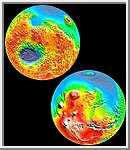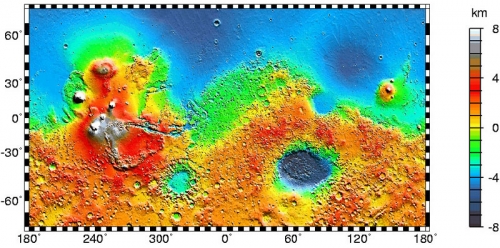Mars has two faces. No, not those kind of faces, but the notable differences between the northern and southern hemisphere. Mars has lowlands in the north and highlands in the south. This disparity has long puzzled planetary scientists, but most concurred that early in Mars history, impacts shaped the planet’s two-faced landscape. But many disagreed whether several small impacts or one big one were responsible for sculpting Mars’ surface. Now scientists at the California Institute of Technology have shown through computer modeling that the Mars dichotomy, as the divided terrain has been termed, can indeed be explained by one giant impact early in the planet’s history.
“The dichotomy is arguably the oldest feature on Mars,” said Oded Aharonson from Caltech. Scientists believe the differences in hemispheric features arose more than four billion years ago.
Previously, scientists discounted the idea that a single, giant impactor created the lower elevations and thinner crust of Mars’s northern region, says Margarita Marinova, a graduate student at Caltech, and one of the lead authors of the study.
For one thing, Marinova explained, it was thought that a single impact would leave a circular footprint, but the outline of the northern lowlands region is elliptical. There is also a distinct lack of a crater rim: topography increases smoothly from the lowlands to the highlands without a lip of concentrated material in between, as is the case in small craters. Finally, it was believed that a giant impactor would obliterate the record of its own occurrence by melting a large fraction of the planet and forming a magma ocean.

“We set out to show that it’s possible to make a big hole without melting the majority of the surface of Mars,” Aharonson says. The team modeled a range of projectile parameters that could yield a cavity the size and ellipticity of the Mars lowlands without melting the whole planet or making a crater rim.
The team ran over 500 computer simulations combining various energies, velocities, and impact angles. Finally, they were able to narrow in on a “sweet spot”–a range of single-impact parameters that would make exactly the type of crater found on Mars. Their dedicated supercomputer allowed them to run simulations not run in the past. “The ability to search for parameters that allow an impact compatible with observations is enabled by the dedicated machine at Caltech,” Aharonson said.
The favored simulation conditions outlined by the sweet spot suggest an impact energy of around 1029 joules, which is equivalent to 100 billion gigatons of TNT. The impactor would have hit Mars at an angle between 30 and 60 degrees while traveling at 6 to 10 kilometers per second. By combining these factors, Marinova calculated that the projectile was roughly 1,600 to 2,700 kilometers across.
Estimates of the energy of the Mars impact place it squarely between the impact that is thought to have led to the extinction of dinosaurs on Earth 65 million years ago and the one believed to have extruded our planet’s moon four billion years ago.
Marinova said the timing of formation of our moon and the Mars dichotomy is not coincidental. “This size range of impacts only occurred early in solar system history,” she says. The results of this study are also applicable to understanding large impact events on other heavenly bodies, like the Aitken Basin on the moon and the Caloris Basin on Mercury.
This report, published in the June 26 issue of Nature, goes along with two other papers on the Mars dichotomy. One published by Jeffrey Andrews-Hanna and Maria Zuber of MIT and Bruce Banerdt of JPL examine the gravitational and topographic signature of the dichotomy with information from the Mars orbiters. Another accompanying report, from a group at UC Santa Cruz led by Francis Nimmo, explores the expected consequences of mega-impacts.
Original News Source: EurekAlert


10^29 joules, i’m sure.
One of the ideas for the formation of the Moon is that a Mars sized object formed at either the SEL4 or SEL5 point. These points are 60 degrees ahead or behind Earth in it’s orbit around the Sun. These points are stable, unless the size of the object gets to be “significant”. It gets big enough to become unstable, then slams into the Earth, producing the Moon.
Perhaps Mars had a similar object at it’s SML4 point, and did this damage.
Perhaps Venus had one, and it goofed up Venus’s spin.
Perhaps Uranus had one, ant it goofed up Uranus’s spin.
There. Now get out your computers and start simulating.
“1029 joules, which is equivalent to 100 billion gigatons of TNT”
hmm…missing SI prefix?
Funny, funny, funny. Have you thought of IMPROV?
If I remember correctly, the impact that created our Moon happened during the Late Heavy Bombardment, around 3.8-4.1 billion years ago. During that time every body in the Solar System must have sustained significantly large impacts. Some of those impacts would have created moons of various sizes, but subsequent impacts — 300 million years is a long time, and a lot of things can happen during it — might have pulverized most of those moons, or kicked them away from their primaries, out of the system or toward the Sun. Mars and Venus may both have gained moons at that time, then lost them again from later impacts. We may have gained our Moon at a time when those impacts were tapering off, as the Solar System was cleaned out by earlier impacts, and kept our Moon because nothing large enough to destroy or kick away our Moon came our way afterwards. Hmmm . . . wonder if anyone’s done a study on those possibilities?
Then why don’t Venus and Mars have large satellites like Earth does? Perhaps Earth received a glancing blow which stripped off a lot of material that eventually became the Moon, but Mars and Venus copped a direct hit which did not result in a heap of orbiting debris.
Perhaps neither were hit by anything significant but one’s core cooled ‘died’ (therefore, lost it’s magnetic field) and the other has no ‘problem’.. it’s just too close to the sun.. I don’t know.. Just a thought..
Nexus, the Large Early Impactor with a glancing blow is the most popular theory of the Moon’s creation. We now call that impact basin, the Pacific Ocean.
Vanamonde: The idea that the Pacific basin had something to do with the origin of the moon was dropped after plate tectonic theory was established. Any basin left by the formation of the moon would be obliterated by the shuffling of the continents over the last 4 billion years.
BTW is your handle a reference to A.C. Clarke’s novel(s) Against the Fall of Night/The City & the Stars ?
It was Nibiru the destroyer! OMFG bbq.
Since the Earth was impacted and the Moon formed plate tectonics/continental drift have ensured that the original impact site has been obliterated even if it actually existed following the molten state of the Earth afterwards. Therefore the Pacific Ocean as the site is sheer nonesense.
Paul.
Yep. It is my understanding that the Earth went pretty much molten when it was struck. Therefore, no impact basin.
I’ve seen part of a report from Queen Mary University in London which was working through the original models. Looking a lot at the melting process which would have occured.
I’m particularly interested in the shock wave which would have gone through the planet and made a nice little mark on the other side (not necessarily at the exact opposite point); and to see what explanations can be found with anomolies in the southern hemispheres magnetic field.
Aodhhan: Like Valis Marineris? That kind of trench definitely could be caused by something very large hitting the opposite side of Mars. Though popular theory suggests that it was formed by the formations of volcanos in the general area, including Olympus Mons.
Nexus Says:
June 25th, 2008 at 4:28 pm
Then why don’t Venus and Mars have large satellites like Earth does?
They were devoured by Unicron
I don’t think the trench would be a product, however it is quite likely such a collision produces a shock wave which bulges and stretches the crust thin enough where a molten interior could get close enough to the surface to break through.
Given the impact, I would have expected to see a volcano more in the southern hemisphere. Although, given the right angle and depending on the make-up of the interior of the planet at the time its possible Olympus Mons is a product of the collision. It will be great to some day get a good geographical study of the interior.
There are typically 2 shock waves which develop from the collision. One along the surface of the planet (which will meet apprx 180 degrees on the other side) and the interior, which could be offset a bit. Speed and power of the internal wave is going to depend on internal resistance.
I was under the impression that the Tharsis Bulge (Olympus Mons, et al) was driven up opposite the impact that created the Hellas Basin.
Perhaps the low land regions of Mars were an ocean once? The southern hemisphere is like the giant continent that used to be on earth.
Also, isn’t the moon much older than the Earth? I’ve also read it’s made out of much different material, so it wasn’t a part of the Earth.